second generation EUROPEAN CORN BORER;
WESTERN CORN ROOTWORM BEETLES and JAPANSE BEETLE feeding on corn silks;
2nd generation of COLORADO POTATO BEETLE;
GRAPE ROOT BORER flight from July thru September.


SPIDER MITES on ornamentals;
second generation EUROPEAN CORN BORER;
WESTERN CORN ROOTWORM BEETLES and JAPANSE BEETLE feeding on corn silks;
2nd generation of COLORADO POTATO BEETLE;
GRAPE ROOT BORER flight from July thru September.


Are you ready to participate in the 2006 Pest Management Survey? If so, go to http://ces.ca.uky.edu/kyipm/opening.htm and complete the survey now. Once you have answered the questions be sure and click on the "SUBMIT FORM" button at the end of the survey. Using a web-based survey, there is a possibility, though remote, that Internet use can be tracked, responses obtained, and users identified, but every effort will be made to remove the data from online access ASAP. If you are receiving this newsletter by the U.S. postal service, you will receive a letter and survey in the next week.
Your answers will be used to evaluate the Kentucky IPM program and to plan future IPM trainings, projects and activities. These projects will benefit Kentuckians and agriculture producers by providing training on procedures that can help reduce pesticide use and exposure. The survey consists of 39 questions related to production and safety practices you use or recommend as a part of farming or as a part of your business. This survey will take 30 minutes or less to complete.
This survey involves research and by completing a survey and submitting your answers, you are giving consent for your answerers to be part of this research project. This survey is voluntary and you may skip any question or stop taking the survey at any time. So, help us evaluate farming practices in Kentucky by participating in the 2006 Pest Management Survey.
One lucky person completing the survey will receive a Tubby Smith autographed UK basketball. If you wish to be included in the random drawing to receive the basketball, just enter your e-mail address at the end of the web survey or a telephone number and first name if you are completing a mailed copy. E-mail addresses and telephone numbers provided will be confidential. They will be used only to select a winner for the basketball and will be removed from your answers. If you would like to participate in this survey but do not wish to complete an on-line form, you can request a copy be mailed to you. To request a mailed copy of this survey or if you have questions about this survey or the research you can contact Patty Lucas, P.O. Box 469, Princeton, KY 42445 or telephone at (270) 365-7541 extension 218 or e-mail at plucas@uky.edu.
Answers and contact information will be confidential. Only one person will view answers, e-mail addresses and telephone numbers supplied to us. Contact information will be removed from the survey as quickly as possible. Once removed, it will not be possible to connect your information and your survey responses. Contact information will be stored separately and destroyed upon completion of the project. You will receive a post card or e-mail as a reminder asking you to participate in this survey. Since we are not keeping records of who participates in the survey, the reminder will be sent to everyone on the mailing list.


The virus complex in Kentucky corn is caused by two viruses that typically occur together: maize dwarf mosaic virus (MDMV) and maize chlorotic dwarf virus (MCDV). Both viruses overwinter principally in rhizomes of johnsongrass. MDMV is transmitted by certain aphids; MCDV is transmitted by the black-faced leafhopper.
Severe cases of the virus complex have shown up in the diagnostic lab in the last few weeks. In susceptible hybrids, both viruses can cause color changes in leaves and stunting, particularly through internode shortening. MDMV causes leaves to turn yellow, usually with mosaic symptoms. MDMV causes leaf blades to turn yellow, often with reddish coloration around the margin of the blade. Plants infected with MDMV also exhibit clearing of the tiniest leaf veins; this symptom is best perceived by carefully comparing symptomatic leaves to healthy leaves by holding them up to the sky and allowing light to pass through them.
Destruction of rhizome johnsongrass prior to seeding a susceptible hybrid is an effective control measure. If the field has more than a trace amount of rhizome johnsongrass, hybrids planted should have some resistance or tolerance to the virus complex. The more badly infested the field is with rhizomes, the more important it is to have a hybrid with resistance or tolerance. Likewise, the later the crop is planted, the more important it is to have a hybrid that can sustain virus activity, since later crops tend to be exposed to more virus pressure.
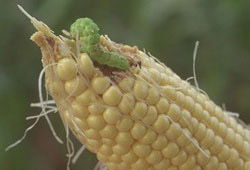 Corn earworm is one of those pests that is with us every year. Some years we have very high levels, others years it is low. Pheromone trap counts over the last several weeks in Princeton have indicated low to moderate moth activity in this area. But even low to moderate numbers can result in serious tip damage to sweet corn when not managed properly. In addition, there have been some initial reports that corn earworm may be developing resistance to pyrethroid insecticides. Pyrethroids have been the effective and economical method to manage corn earworm.
Corn earworm is one of those pests that is with us every year. Some years we have very high levels, others years it is low. Pheromone trap counts over the last several weeks in Princeton have indicated low to moderate moth activity in this area. But even low to moderate numbers can result in serious tip damage to sweet corn when not managed properly. In addition, there have been some initial reports that corn earworm may be developing resistance to pyrethroid insecticides. Pyrethroids have been the effective and economical method to manage corn earworm.
Growers during the next few weeks should monitor their sweet corn during ear development to determine if they are getting the level of control that they are expecting. If corn earworm numbers in the developing eartip are not what is expected, then growers need to ask themselves, was my coverage with insecticide adequate, was the timing appropriate to prevent infestation, and were the application intervals close enough to maintain control. If there was not a problem with any of these, then they may want to consider a non-pyrethroid alternative (See ID-36).
Corn earworm is the most serious sweet corn pest because it feeds directly on the market product. Once worms have become established within the ear, control is impossible. Earworms are variable in color, but they have a brown head without markings and numerous microscopic spines covering their body. A preventive program, especially on late season corn, is necessary to ensure that damaged ears are at a minimum.
Female moths search out fresh, green silks on which to lay single eggs. Following hatch, the small larvae begin to feed on the silk. Corn earworms generally complete their development in 14 to 16 days. Full grown worms leave the ear and pupate in the soil. The new adult will be active in another 10 to 14 days.
A preventive program against corn earworms may begin when 10% of the ears are silked. Repeated sprays at three to five day intervals until 90% of the silks have wilted should give a high percentage or worm free ears during early and midseason. Control is more difficult late in the season. Even shortening spray intervals may produce only 90% clean ears. Spray solution should be driven deep into the silks. The use of drop nozzles to direct the spray at the middle third of the plant provides the best coverage and control. Corn hybrids having a long, tight fitting shuck appear to suffer less damage than those with loose shucks.
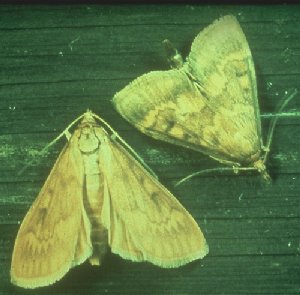 The UK Ag Weather Center model indicates that first generation European corn borer moths are in flight across the state. This computer model developed by Dr. Grayson Brown has provided accurate forecasts of European corn borer activity. This enables corn and pepper producers to be more efficient with monitoring and management activities.
The UK Ag Weather Center model indicates that first generation European corn borer moths are in flight across the state. This computer model developed by Dr. Grayson Brown has provided accurate forecasts of European corn borer activity. This enables corn and pepper producers to be more efficient with monitoring and management activities.
Preventive insecticide applications for second generation European corn borer are NOT RECOMMENDED in Kentucky for several reasons. What is recommended is that fields be scouted for corn borers. If borers exceed the treatment threshold of an average of one egg mass per plant and egg hatch has begun or if 50% of the plants have live larvae feeding on the leaves, tassels, behind sheaths, or in leaf axils. Timing of insecticide applications is very important for corn borer control. Treatments are ineffective if applied after the larvae have entered the stalk.
In general, insecticidal control of the second generation is more difficult for several reasons. First, because this generation is not as well synchronized egg laying will occur over a much longer period of time and populations may reach threshold two or three times, and the cost of control may exceed the value of the potential losses. Larvae feed in the leaf axil and are difficult to reach with an insecticide. For these reasons, identification of heavily infested fields and their early harvest (where possible) may be an effective strategy to reduce losses due to broken or lodged plants and ear drop.
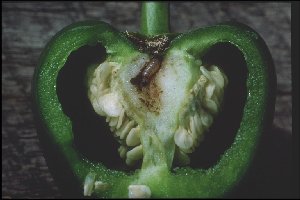 Pepper growers will need to protect their crop from corn borer attack as well. Corn borers bore into pepper fruit just beneath the cap of the pepper. Control needs to be made before the larvae bore into the fruit. Typically 2 or 3 sprays 7 to 10 days apart provide good control of second generation corn borers.
Pepper growers will need to protect their crop from corn borer attack as well. Corn borers bore into pepper fruit just beneath the cap of the pepper. Control needs to be made before the larvae bore into the fruit. Typically 2 or 3 sprays 7 to 10 days apart provide good control of second generation corn borers.
For information about corn pests, visit
"Insect Management Recommendations".


Last week, several cases of Scolecotrichum leaf blight were diagnosed in orchardgrass. This disease appears as tan or tannish-orange blotches of dead tissue on leaf blades. Blighting (rapid death of portions of the leaf blade) often appears toward the upper half of the leaf. Under a hand lens one can see very tiny black pimple-like structures, which is where the spores are produced. Though we commonly see this disease in orchardgrass during summertime in Kentucky, the damage this year seems to be worse than normal.
For management, cutting hay crops will help reduce disease progress. Also, be sure to select cultivars of orchardgrass that have proven themselves to be well-adapted to Kentucky conditions. The best way to determine this is to evaluate their performance in the UK Extension Agronomy's orchardgrass variety evaluations. You can find these results online at http://www.uky.edu/Ag/Forage/ForageVarietyTrials2.htm.


County Extension Agents and tree owners sometimes inquire about the abnormal swellings or burls that appear as large aberrant growths or tumors on the trunk of a tree. It is often assumed by the questioner that these unusual growths must be a bacterial infection like crown gall or a fungal gall like black knot, or perhaps insect galls.
These large woody swellings, almost hemispheric in shape, are called burls and they are occasionally found on certain deciduous trees such as black cherry, sugar maple, and black walnut. Burl wood with its swirling wood grain is highly prized by wood workers. The wood often contains many buds which causes the wood grain to swirl around each bud trace.
The actual cause of burls is not fully understood, but the determining factor may be related to a wound response. It is possible that some burls begin when there is a disruption of a small part of the vascular cambium, and the disruption continues for the life of the tree. The tree could receive a relatively mild injury from an insect or microbe early in its life that initiates a tree defense response, and woody tissues form. In some cases, the defensive mechanism within the tree may fail to shut itself off, resulting in a massive overgrowth of cells on the trunk or branches. Specific pathogens, toxins or insects have not been found to be directly involved. Most affected trees usually continue to grow without experiencing any decline, however burls on little leaf linden are often associated with premature tree decline.
Unlike crown gall or black knot diseases, burls do not appear to be contagious, so if one tree in a group has a burl, it doesn't necessarily mean that others nearby will develop them soon.
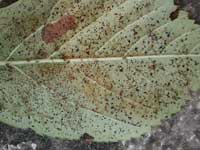 Gradual loss of leaf color by sycamores and azaleas may be due to feeding by distinctive sap feeding insects known as lace bugs. Adult lace bugs are 1/8" to 3/16" long insects with clear, ornate, lacy wings. Nymphs are spiny and wingless. Their feeding activity causes tiny spots on leaves that eventually coalesce into larger whitish areas. Also, undersides of the leaves become spotted with dark varnish-like excrement and covered with shed exoskeletons of developing bugs. Populations are greatest in mid- to late summer as the second generation appears.
Gradual loss of leaf color by sycamores and azaleas may be due to feeding by distinctive sap feeding insects known as lace bugs. Adult lace bugs are 1/8" to 3/16" long insects with clear, ornate, lacy wings. Nymphs are spiny and wingless. Their feeding activity causes tiny spots on leaves that eventually coalesce into larger whitish areas. Also, undersides of the leaves become spotted with dark varnish-like excrement and covered with shed exoskeletons of developing bugs. Populations are greatest in mid- to late summer as the second generation appears.
Azalea lace bugs are about 1/8" long with light brown bodies. They prefer evergreen varieties but attack deciduous varieties and mountain laurel. Sap removal by adults and nymphs causes a spotting visible on the upper leaves. In heavy infestations, leaves may be white and drop prematurely. Sycamore lace bugs have the same general life cycle as the azalea lace bug. In addition to symptoms on the foliage, the insects may fall from the trees onto people below. Attempts by lace bugs to probe can result in a "bite" sensation which can be very annoying, especially when lace bug are at their peak. Some people may have a slight reaction to the bite but the insects are not a health threat.
Most lace bugs spend the winter as eggs that hatch in early spring. There may be several generations during a season. With multi-generation species, numbers early in the season are so small that feeding symptoms may not be noticed. Populations peak in late summer and results of their feeding can make plants unsightly.


 House flies move easily back and forth from garbage and manure to exposed human foods, eating utensils, and food preparation areas. At each stop, they use saliva and their sponging mouthparts to liquefy and blot up solid food. As a result, their feet and mouthparts may be teeming with bacteria or viruses that are easily transferred to other surfaces. These pathogens can cause diarrhea, food poisoning, or a host of other human and animal health problems. Consequently, house fly management is very important health issue. Key factors include sanitation and exclusion, which may supplemented with physical or chemical control.
House flies move easily back and forth from garbage and manure to exposed human foods, eating utensils, and food preparation areas. At each stop, they use saliva and their sponging mouthparts to liquefy and blot up solid food. As a result, their feet and mouthparts may be teeming with bacteria or viruses that are easily transferred to other surfaces. These pathogens can cause diarrhea, food poisoning, or a host of other human and animal health problems. Consequently, house fly management is very important health issue. Key factors include sanitation and exclusion, which may supplemented with physical or chemical control.
Lack of good sanitary practices generally leads to problems with house flies in an area because these insects can breed very rapidly in relatively small volumes of many types of decaying organic matter. In the summer, flies can develop from eggs to adults in 7 to 10 days. Weekly waste removal keeps areas from being attractive to flies and denies them breeding material. Picnic and park areas should have adequate numbers of containers lined with plastic bags and fitted with lids so that flies cannot get to discarded food and drinks. The trash should be collected weekly and the insides of cans washed regularly to remove material that leaks from broken bags.
Most house flies in structures are invaders from the outside. They should be excluded by screened doors and windows and sealing of as many cracks as possible. Wind screens from fans or hanging plastic curtains also may reduce fly access. These will work best if there are few flies around because the sanitation program is very effective. Sticky fly papers or strips can capture the occasional stray inside but will not collect large numbers of flies in heavy infestations. Commercial fly traps also can be effective against very low numbers of flies but will not be adequate in the face of lots of flies and attractive nearby food sources. Attractants used in commercial traps usually smell bad so the traps must be located away from areas where people will be working or eating. Fly traps that use UV light may be effective indoors if they are not competing with sunlight from windows or doors.
Application of an insecticide can be useful as a temporary measure to knock down adult numbers but should not be the only or main strategy that is used. There are several alternatives including space sprays, residual sprays, and fly baits. Space sprays with pyrethrins, and the synergist piperonyl butoxide, provide quick knock down of flies but leave no residual effect. Application is made with a fogger that produces many fine droplets which must hit active or resting flies directly. Residual sprays can be applied to fly resting sites with a compressed air sprayer. Those containing pyrethroid insecticides will give several days of residual protection to flies landing on treated surfaces. Effectiveness often is reduced on porous or painted surfaces. Fly baits can be scattered over areas to kill flies that come to them to feed. They have the best chance of providing fly reduction where there are few other competing food sources.




For more information livestock pests, visit "Insect Management Recommendations".


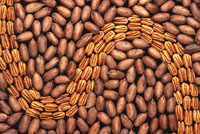






Agronomic samples received in the PDDL this past week included Rhizoctonia root/crown rot and spring black stem on alfalfa; Scolecotrichum leaf blight on orchardgrass (See Dr. Vincelli's article in this issue of KPN); Fusarium root rot on sorghum; potassium deficiency, thrips injury and lightning injury on soybean; black shank, blue mold, tomato spotted wilt virus, Fusarium wilt, brown spot, manganese toxicity, temporary phosphorus deficiency, potassium deficiency; transplant shock, frogeye leaf spot, target spot, frenching and weather fleck (ozone injury) on tobacco.
On fruit and vegetable samples, we diagnosed black rot on grape; cedar-apple rust on apple; Phytophthora root rot on persimmon; tipburn and bacterial soft rot on cabbage; and bacterial canker and root knot nematode on tomato.
Ornamental and turf samples included Pythium root rot on petunia; Rhizoctonia root rot on chrysanthemum; Cryptocline leaf spot on birch; Pestalotia twig blight on taxus; powdery mildew on euonymus; Phytophthora collar rot on cherry; Hypoxylon canker and tar spot on maple; and necrotic ringspot on bluegrass.


UKREC-Princeton, KY, June 30-July 7, 2006| True Armyworm
| 183
| Corn Earworm
| 16
| European Corn Borer
| 0
| Southwestern Corn Borer
| 21
| Fall Armyworm
| 1
| Black Cutworm
| 3
| | |
View Princeton trap counts for the entire 2006 season at - http://www.uky.edu/Ag/IPMPrinceton/Counts/2006trapsfp.htm
Fulton County trap counts are available at -http://ces.ca.uky.edu/fulton/anr/Insect%20Counts.htm
For information on trap counts in southern Illinois visit the Hines Report at - http://www.ipm.uiuc.edu/pubs/hines_report/comments.html The Hines Report is posted weekly by Ron Hines, Senior Research Specialist, at the University of Illinois Dixon Springs Agricultural Center.
Several of Kentucky's largest or most unusual insects will be active during July and early August. A few that are most likely to appear and arouse curiosity are:
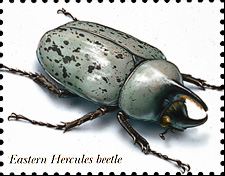 1. The eastern Hercules beetle (Dynastes tityus) has a large (2" to 2-1/2" long) greenish-gray to black body. Males have a large distinctive horn on the head and sometimes are called rhinoceros beetles. The adults are attracted to lights during mid- to late summer. The larvae are large white grubs that feed in the center of decaying logs and stumps. It is the largest beetle in Kentucky and is harmless. These beetles occur throughout the southeast.
1. The eastern Hercules beetle (Dynastes tityus) has a large (2" to 2-1/2" long) greenish-gray to black body. Males have a large distinctive horn on the head and sometimes are called rhinoceros beetles. The adults are attracted to lights during mid- to late summer. The larvae are large white grubs that feed in the center of decaying logs and stumps. It is the largest beetle in Kentucky and is harmless. These beetles occur throughout the southeast.
2. Dobsonflies are large, prehistoric-looking insects. They have soft gray bodies and two pair of wings with a network of veins. These fluttery-flying insects are usually found near creeks or streams. The male has an impressive pair of long, slender mouthparts. Females have the same body shape but very small mouthparts.
a. The female dobsonflies lay their eggs on overhanging branches or structures over streams. The larvae called "hellgrammites" usually occur under stone in streams where they feed on insects that live in the water. The larvae live for several years in the water and are used as bait by fishermen. The adults only live a few days to reproduce, then die.
3. Giant water bugs have a variety of common manes as "toe biters", "fish killers", and "electric-light bugs". They are large (about 2.5 inches long) with flat, brown, oval bodies, large eyes and a pair of grabbing front legs. These insects are good fliers and can show up as uninvited guests in swimming pools. These water bugs live in quiet standing water of ponds, lakes, and stream pools, where they feed on aquatic insects, snails, tadpoles, and even minnows. While not dangerous, they can inflict painful bite if handled.
4. The European hornet, about 1.5 inches long, is an impressive and fearsome-looking insect. It is brown with yellow markings, particularly at the end of the abdomen. European hornets generally nest in cavities in trees or other protected sites. They will fly at night and are attracted to lights. More information is available in Entfact 600 - The European Hornet in Kentucky. http://www.uky.edu/Agriculture/Entomology/entfacts/struct/ef600.htm
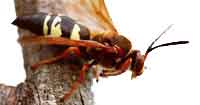 5. The cicada killer wasp (about 2 inches long) can be seen cruising over grassy areas during July and August. They are black with yellow markings and rusty-colored wings. These wasps burrow into sandy or well-drained soil with sparse grass color. They live in individual burrows but where conditions are right, large groups can build up over time. They are curious but not aggressive. The females can sting and will if handled but do not respond in attacking masses like yellowjackets or other common social wasps.
5. The cicada killer wasp (about 2 inches long) can be seen cruising over grassy areas during July and August. They are black with yellow markings and rusty-colored wings. These wasps burrow into sandy or well-drained soil with sparse grass color. They live in individual burrows but where conditions are right, large groups can build up over time. They are curious but not aggressive. The females can sting and will if handled but do not respond in attacking masses like yellowjackets or other common social wasps.

NOTE: Trade names are used to simplify the information presented in this newsletter. No endorsement by the Cooperative Extension Service is intended, nor is criticism implied of similar products that are not named.
Lee Townsend
Extension Entomologist